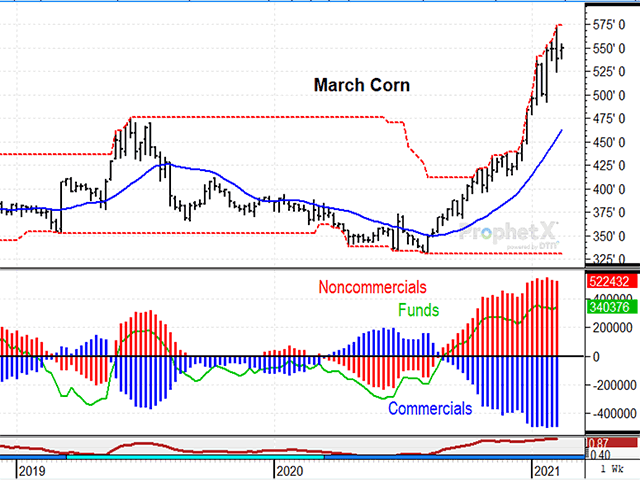Todd's Take
Corn, Soybean Traders' Positions Irrelevant for Now
In DTN's market strategies, noncommercial positions are one of the six factors we include in the assessment of each commodity, and for good reason. A heavy presence of noncommercials (or speculators) on the long side of a market is often a strong warning sign of prices at risk of falling lower.
Not all noncommercials are created equal but, in general, they do share common characteristics. Noncommercials typically behave as trend-followers and have a knack for loading up on positions at the wrong time. As the name suggests, this group of investors is not involved in the commercial aspects of the commodities they trade and their lack of understanding of basic value is often evident. Noncommercial positions make good contrarian indicators.
Combine a heavy noncommercial position with prices challenging long-term highs -- at a time of year when seasonal peaks are common -- and you have a pretty good combination of factors shouting "sell." Recent examples of selling clues like this happened for corn in 2014, 2015, 2016, 2018 and 2019. Similar examples for soybeans occurred in 2014, 2016 and 2018.
As we saw in late 2020, however, noncommercial positions are not always wrong. Every now and then, this trend-following segment of the market connects to a large fundamental shift. When they do, the combination of noncommercial money, plus a legitimate fundamental change, produces powerful price trends in the market.
P[L1] D[0x0] M[300x250] OOP[F] ADUNIT[] T[]
A prime example of noncommercial success took place from 2006 to early 2008. At that time, noncommercials caught the long side of corn and soybean prices, surging higher in response to new ethanol mandates. A lesser example was in 2011 and 2012 when prices moved higher on adverse weather.
In late 2020, U.S. corn and soybean prices increased dramatically as a result of a late stretch of dry weather in the U.S. and an unexpected surge of demand for grains and oilseeds from China. China's demand has been so strong that corn and soybean prices ignored their usual seasonal lows in the fall and embarked on rallies that may not be over yet.
Looking ahead to 2021, U.S. soybean supplies are so tight that imports will likely be needed this summer. Thursday morning, USDA estimated spring plantings at 92 million acres for corn and 90 million acres for soybeans. My early math says 90 million acres of soybeans will not be enough to maintain the present thin margin of supplies into 2021-22; much depends on China's demand. Unfortunately, the U.S. has no credible insight into the status of grain in China and we are left to make our best guesses.
Even though China isn't talking, we do have market clues to watch in 2021 and, in this situation, China's prices are important pieces of information. As of Thursday, Feb. 18, May corn on China's Dalian exchange settled at the equivalent of $11.01 per bushel; March soybeans translated to $18.68 a bushel. Both prices are high enough to suggest China still needs more of both and demand should remain active in 2021.
With U.S. corn and soybean supplies at their tightest levels in seven years, and both prices showing no sign of breaking below support yet, noncommercials are under no pressure to liquidate their positions.
I can't say how long this bullish state of affairs will last but, for now, that heavy speculative crowd in corn and soybeans is not the same bearish threat we have often seen in the past. Technically speaking, what would turn the situation more bearish, even if just for the short term? A close in March corn below $5.25 and a close in March soybeans below $12.98.
Until then, trader positions can be ignored as these prices look well supported.
Todd Hultman can be reached at Todd.Hultman@dtn.com
Follow him on Twitter @ToddHultman1
(c) Copyright 2021 DTN, LLC. All rights reserved.




